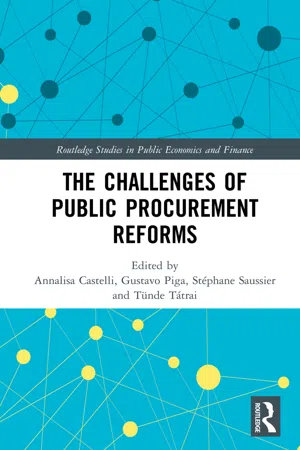
The Challenges of Public Procurement Reforms
Annalisa Castelli, Gustavo Piga, Stéphane Saussier, Tünde Tátrai, Annalisa Castelli, Gustavo Piga, Stéphane Saussier, Tünde Tátrai
- 232 Seiten
- English
- ePUB (handyfreundlich)
- Über iOS und Android verfügbar
The Challenges of Public Procurement Reforms
Annalisa Castelli, Gustavo Piga, Stéphane Saussier, Tünde Tátrai, Annalisa Castelli, Gustavo Piga, Stéphane Saussier, Tünde Tátrai
Über dieses Buch
Public procurement affects a substantial share of world trade flows, amounting to 1000 billion euros per year. In the EU, the public purchase of works, goods and services has been estimated to account on average for 16 percent of GDP. The novelty of this book is that it focuses on the new European Union Directives approved in 2014 by the EU Parliament.
The book consists of original contributions related to four specific themes of interest to the procurers' day-to-day role in modern public purchasing organizations – both economists and lawyers – allowing for relevant exchanges of views and "real time" interaction. The four sections which characterize the book are Life-cycle Costing in Public Procurement; Calculating Costs and Savings of Public Procurement; Corruption and Probity in Public Procurement and Public Procurement and International Trade Agreements: CETA, TTIP and beyond. These themes have been chosen for their current relevance in relation to the new European Public Procurement Directives and beyond. The original format features, as is the case with the first three volumes, an introductory exchange between leading academics and practitioners, from differing disciplines. It offers a series of sequential interactions between economists, lawyers and technical experts who supplement one another, so as to enrich the liveliness of the debate and improve the mutual understanding between the various professions.
This essential guide will be of interest to policymakers, academics, students and researchers, as well as practitioners working in the field of EU public procurement.
Häufig gestellte Fragen
Information
1Life-cycle costing in public procurement
Colloquium
Opening remarks – Stéphane Saussier
Moving beyond price criteria
The most economically advantageous tender from the point of view of the contracting authority shall be identified on the basis of the price or cost, using a cost-effectiveness approach, such as life-cycle costing […]. It may include the best price-quality ratio, which shall be assessed on the basis of criteria, including qualitative, environmental and/or social aspects, linked to the subject-matter of the public contract in question.
Life Cycle Costing shall to the extent relevant cover parts or all the following costs over the life cycle of a product, service or works:
At what cost?
Where contracting authorities assess the costs using a life-cycle costing approach, they shall indicate in the procurement documents the data to be provided by the tenderers and the method which the contracting authority will use to determine the life-cycle costs on the basis of those data.